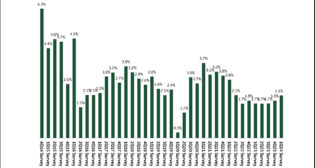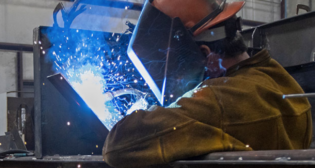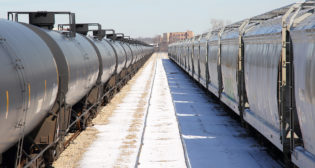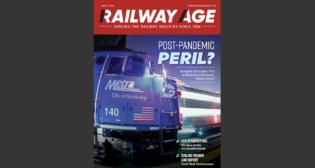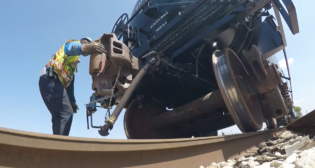
Analysts, legal and financial experts weigh in on DOT’s HHFT NPRM
Written by William C. Vantuono, Editor-in-Chief“The recent DOT/PSHMA proposed rule change for DOT-111A tank cars does not directly answer the question of what car is preferred for hauling crude oil, but it does provide some thoughts about how the process might move forward,” said Railroad Financial Corp. Senior Vice President and Railway Age Contributing Editor David Nahass. “It is clear after reading the literature that the DOT would prefer the 9/16-inch-steel car design. That standard should have been established and the issue should be put to rest. Unfortunately there are so many hands in the cookie jar regarding this issue that a straightforward proclamation seems unfeasible right now. If the DOT had established the 9/16-inch standard earlier without delay, all parties in the industry would have processed the change in specification and moved beyond it. Then the issue of retrofits could have been handled separately, with a critical eye and a focus on the business and safety aspects of a massive shift in transportation fundamentals.
“For the railcar builders, the solution is easy: Start selling the 9/16-inch car exclusively. A universal decision by the five (Union Tank Car, Trinity, ARI, National Steel Car, and Greenbrier) tank car builders to move to this design would end the debate and allow the regulatory agencies to focus on the retrofit issue exclusively. The mixing of the two issues (new car design and the retrofit) makes the solution and final resolution that much more complicated and invites an endless parade of commentary and debate. There are already too many parties involved in the decision-making process; inviting more to the party will make users and the public wonder if there will be a final resolution within the next 12 months.
“How frustrated are people in the railcar world by these recent events? One industry insider told me that the new regs are begging for an ‘American Idol’ style resolution. My source suggested that the DOT hire Simon Cowell to bring resolution swiftly. ‘America, it’s time for you to text your vote for the next generation tank car specification to . . . . ’ ”
“Crude oil and ethanol needs to move by rail, but it needs to move more safely. The proposed rule is the government’s effort to meet this goal, but the rule is going to present challenges for everyone in the supply chain,” said Nossaman LLP Partner Kevin Sheys. “Digesting the rule and preparing meaningful comments within 60 days will be a challenge. I think most in the industry will be pleased that the government offered three tank car options for comment instead of just listing the issues and throwing it open for proposals. The sunset of DOT-111s in two years, a year earlier than the three-year phase-out in Canada, would mean these cars might see their last days of service in Canada. I would not be surprised to see the Canadian government reduce its phase-out to match.”
“We view this as a step closer to a net positive for tank car manufacturers,” said Eric Crawford of UBS Investment Research– Machinery, Engineering & Construction, Industrials. “We continue to view tank car regulation as a net positive for tank car manufacturers, albeit somewhat tempered by the potential for regulation to favor retrofitting over outright replacement, which we have viewed as a more likely outcome. The NPRM is a step toward clarity that should come when a final standard is enacted.
“The NPRM provides some detail on retrofitting options, and the costs are not onerous. PHMSA cost estimates for retrofitting an unjacketed DOT-111 tank car range from $26,730 to $33,400, depending on which option is adopted. Our initial view is that Option 3 might make the most sense to adopt. Given the NPRM highlighted 13 train derailments that occurred at an average speed of 32.4 mph, we suspect little added benefit from improved puncture resistance at 12.3 mph with Option 1 and 2 vs. 9.6 mph with Option 3. As Option 3 is less expensive and roughly equivalent to 1 and 2 in other categories, we believe it makes the most sense to adopt.” Download UBS’s full report HERE.
“In our view, the draft crude/ethanol rail safety rules take both the mega-upside tank car replacement case (‘let’s replace everything today’) and downside case (‘only crude’) off the table, while proposed crude speed limits were better for the rails than feared,” said to analysts Bascome Majors and Christopher N. Stathoulopoulos of SIG Susquehanna Financial Group LLLC. “With regulators trying to make retrofitting a viable option, the tank car replacement upside case now rests more squarely on shippers’ and operating lessors’ self-regulation/risk aversion.”
“This is a draft, and the final rule will inevitably change,” said Majors and Stathoulopoulos. “Yesterday’s proposal cleared up uncertainty around several key variables in PHMSA’s rulemaking, but leaves some questions unanswered and is subject to a 60 day comment period (ending 9/21). In short, there will be changes before the rule is finalized, which we continue to expect in late 2014/early 2015.”
Following is a summary of the SIG analysts’ analysis. A PDF of their full report can be downloaded HERE:
“Intended Scope—Crude & Ethanol Unit Trains: Regulators’ proposed tank car packaging and train speed limitations are directed at High-Hazard Flammable Trains (HHFT), which they’ve tentatively defined as trains with 20-plus cars carrying flammable liquids. This definition is critical to the scope of the rule, as it is intended to impact crude and ethanol unit train service, but not other flammable liquids traveling in smaller blocks in manifest train service. This focus on crude and ethanol unit trains was inline with our base case expectation, and takes one regulatory replacement upside case off the table (i.e., cars carrying flammable liquids beyond crude/ethanol will likely not need to be retrofitted/replaced) as well as one downside case (ethanol cars get a major break vs. crude). This scope would imply a retrofit vs. replace decision will need to be made on a population of approximately 72,000 existing tank cars (PHMSA’s number, including both newer CPC-1232 and legacy DOT-111s). Our estimates of this fleet by commodity and car type are very similar.
“For the Railroads—Crude Train Speed Limits Less Restrictive than Feared: Regulators have proposed a maximum speed limit of 50 mph for all HHFTs (including those running cars built to new “enhanced” standards), and are seeking comment on three different options for trains with at least one tank car not meeting new standards: 1) 40 mph in all areas, 2) 40 mph in areas with 100K-plus populations (est. impact on 10% of crude/ethanol track miles), or 3) 40 mph in certain high-threat urban areas (this is the voluntary restriction in place as of 7/1, est. impact on 2% of crude/ethanol track miles). Trains that are fully compliant with new tank car standards would see less disruptive 50 mph restrictions in all areas (inline with current voluntary restrictions), while 30 mph restrictions are being considered for trains that don’t meet certain braking system requirements. The good news is that a blanket 30 mph restriction seems to be off the table, as this was the rails’ biggest single concern with respect to this rulemaking. We see this rule as catalyzing more commercial incentives from the rails to push customers into newer/safer tank cars (e.g., the Canadian rails’ surcharges for shipping crude in legacy DOT-111s).
“New Tank Car Standard—Key Variable of Tank Thickness Undecided: The DOT provided a cutoff date of 10/1/2015, after which tank cars entering HHFT service must be constructed to new standards. Most features in this new spec were inline with our expectations (including mandatory jacketing and thermal protection). But regulators left one key variable in those standards open by asking for comments on whether future cars should be built with 9/16-inch tank shells (with or without rollover protection and enhanced brake systems) or 7/16-inch shells (which the post-2011 jacketed CPC-1232 fleet is being built to today).
“Tank Car Retrofits—Risk Based Phase-Outs Over Three to Four Years; DOT’s Press Release Initially Misleading: We believe tank car OEM shares’ initial positive reaction to the draft rule was based on the DOT press release’s suggestion of a tywo-year phase-out of older cars from most Bakken crude oil service. On closer reading of the full rule, regulators are proposing a risk-based tiered phase-out timeline that starts on the day the new car standards go into effect in 2015, with Packing Group 1 commodities (includes most Bakken crude) required to be in new/retrofitted cars by Oct-2017 (3.2 years from today), Packing Group 2 (includes all ethanol, some crude) by October 2018 (4.2 years), and Packing Group 3 by October 2020 (6.2 years). As the bulk of crude/ethanol being carried in unit trains falls into Packing Groups 1 and 2, practically speaking, we see this as a three- to four-year phase-out, inline with the three- to five-year expectation we outlined in our preview report a few weeks ago.
“Tank Car Retrofits—Regulators Want Retrofitting To Be a Viable Option: New regulations more clearly defined the population of tank cars facing the retrofit vs. replace decision, but where car owners eventually fall on that continuum has significant implications for true ‘scrap and replace’ new car demand and tank car OEMs. The draft rule takes some of the retrofit concerns we’ve gathered from industry contacts off the table, with 1) lower than feared cost estimates per car (peaking at $30,000 to $35,000 per car including jacketing vs. estimates we’d seen as high as $60,000), and 2) a solution for retrofitting today’s 7/16-inch and 8/16-inch tank shells to the potential 9/16-inch future requirement (explicitly suggesting this can be done via a thicker jacket, rather than replacing the core shell). Time and channel checks will tell how viable these options truly are, but the regulators’ message that they don’t want to render large portions of the fleet as instantly obsolete is pervasive throughout the draft rule.
“Wild Card—What Car Owners Have To Do Isn’t Necessarily What They Will Choose To Do: Overall, we view the draft regulations as more balanced than feared by either the railroads or railcar owners, and largely inline with our base case expectations outlined two weeks ago (population similar, phase-out window slightly more aggressive). But just because owners can retrofit an older crude or ethanol car at better financial return than replacing it doesn’t mean they will, as they must also consider real and headline risk aversion toward not using the ‘state of the art’ new product. We see major railcar operating lessors and energy industry tank car owners as beginning to make, or at least frame, difficult tank car fleet decisions over the next two to three months, and believe the true eventual impact of the draft regulation will become clearer in our conversations with them over that timeframe. In other words, stay tuned . . . .”
